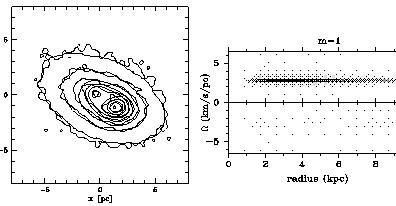


5.2. Lopsidedness and m = 1 asymmetries
The m = 1 perturbation is present in most galactic disks (Richter & Sancisi 1994), often superposed to the m = 2 ones. These perturbations can be of different nature and origin, according to their scale (nuclear or extended disk), or whether they involve the gaseous or stellar disks.
Linear analysis, supported by numerical calculations, show that gaseous disks rotating around a central mass, are unstable for low value of the central mass (Heemskerk et al 1992). The instability disappears when the central mass equals the disk mass. For a gaseous disk, which can develop acoustic waves, and subject to the indirect term (or off-centering of the center of mass) as amplifier, an m = 1 can form and grow (Shu et al. 1990, Junqueira & Combes 1996).
For nuclear stellar disks, long lasting oscillations of a massive nucleus
have been observed
(Miller & Smith
1992,
Taga & Iye 1998).
For extended disks, off-centered in an extended dark halo,
lopsidedness could survive, if the disk remains in the region
of constant density (or constant
 (r)) of the halo
(Levine & Sparke
1998).
(r)) of the halo
(Levine & Sparke
1998).
In the special case of a stellar nuclear disk around a massive black-hole, it is possible that self-gravity is sufficient to compensate for the differential precession of the nearly keplerian orbits, and that a long-lasting m = 1 mode develops, or is maintained long after an external excitation (Bacon et al. 2000). This could be the explanation of the double nucleus observed for a long time in M31 (Bacon et al. 1994, Kormendy & Bender 1999), and for which an eccentric disk model has been proposed (Tremaine 1995, Statler 1999). In this m = 1 mode, the maximum density is obtained at the apocenter of the aligned elongated orbits. The pattern speed, equal to the orbital frequency of the barycentre of the stellar disk, is slow (3 km/s/pc, fig 17), with respect to the orbital frequency of the stars themselves (250 km/s/pc in the middle of the disk). The excitation of the m = 1 perturbation can then last more than 3000 rotation periods. This could be a frequent phenomenon around supermassive black-holes.
The decoupling of the nuclear disks also implies the possibility of decoupled z-oscillations, and it is frequent to observe these nuclear regions inclined at a different angle than the main disk. Jet orientations are not correlated with large-scale disk orientations in Seyfert Galaxies (Kinney et al. 2000), while they should be perpendicular to the accretion disk. As a well-studied example is the Galactic Center, our nearest supermassive black hole. There must be fueling in action. There is a large-scale bar, a nuclear bar/spiral, an m = 1 off-centring, a tilted disk (warped?) etc...

|
Figure 17. HST map in the visible of the nuclear disk surrounding the black hole of M31: thin lines are the observed contours, thick lines are those of the m=1 model simulations (left). Pattern speed as a function of radius, for the m = 1 mode obteined in the simulation (right), from Bacon et al (2000). |